Amazing Endurance Contests
Greatest Indian Club Swinging Champions and the Most Amazing Endurance Contests of all time. By Ben Miller.
Incredible Athletic Contests
During the late 19th and earliest 20th centuries, some of the most incredible athletic contests of all time were held, lasting for days on end with absolutely no rest, and held in front of spectators numbering in the tens of thousands.
Although these feats would seem unlikely or downright impossible to modern athletes today, they did in fact occur, and what is even more amazing, is that its arguably greatest and most astounding champion has today been completely forgotten.
Health, Strength, and Artistic Beauty
These contests involved Indian Clubs, one of the most popular exercise implements of the 19th century, used for health, strength, and artistic beauty, and often exhibited on stages before large crowds, where they were swung in a wide variety of continuous and complex movements.
Although Indian clubs had been used in Britain since the early 1800s, the first club-swinging contests that we know commenced there in the early 1860s, though there is little information regarding the conditions under which they took place.
First Club-Swinging Championship
In America, the first club-swinging championship was held in 1866, at Irving Hall in New York City, and was won by J. Edward Russell, who was judged for his superior grace and brilliancy of execution.
Gus Hill
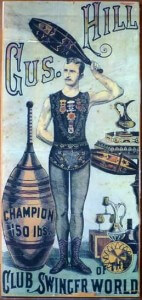 The first true American club-swinging celebrity, however, appeared in 1876 in the person of Gus Hill. A wrestler and native of New York City’s dangerous Bowery district, Hill began swinging at age 15, and debuted in 1876 at Madison Square Garden with P. T. Barnum’s Circus, in a performance hailed as “marvellous.” In the following years, he proceeded to boldly issue a number of challenges in national newspapers, such as the following:
The first true American club-swinging celebrity, however, appeared in 1876 in the person of Gus Hill. A wrestler and native of New York City’s dangerous Bowery district, Hill began swinging at age 15, and debuted in 1876 at Madison Square Garden with P. T. Barnum’s Circus, in a performance hailed as “marvellous.” In the following years, he proceeded to boldly issue a number of challenges in national newspapers, such as the following:
“I hereby challenge any man in the world to swing Indian clubs with me, for either time, style, grace, movements, endurance, executions and combinations, for from $250 to $1,000 per side, clubs to weigh from five to eighty pounds. I will also wager that I can swing a pair of eight-pound clubs for five successive hours, or a pair of five-pound clubs for three days, five minutes in every hour, and last but not least, I will bet that I can swing a heavier club than any man living.
There are many would-be champion club swingers in the country, and to show the public and sporting people who really is the champion I am open to swing clubs against anyone… Until defeated I remain. Yours truly”

“Champion Clubs Swinger of the World.”
While touring the country, Hill printed a standing challenge in the programmes of every event at which he appeared, offering to swing clubs against any man present for $5,000 dollars per side—the modern equivalent of roughly 120 thousand dollars. Some of Hill’s public challenges were especially colourful. In 1882, he stated:
“I am prepared to swing light and heavy clubs against any man in America, blindfolded, or I will match a female pupil of mine against any club swinger… Now let me see what my rivals and imitators have to say.”
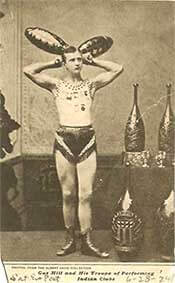 Although he defeated countless competitors, decades later, it was claimed that Hill had used large hollow clubs containing weights that he would unload just prior to his swinging demonstrations.
Although he defeated countless competitors, decades later, it was claimed that Hill had used large hollow clubs containing weights that he would unload just prior to his swinging demonstrations.
Taking into account some of Hill’s claims—such as swinging a 150lb club, for instance, this is not difficult to believe, and Hill certainly was a showman. Still, whatever the case, considering the countless contests he won with judges present to inspect his clubs, as well as the glowing reviews he nearly always received, there is no doubt that Hill was an extremely formidable and highly skilled club swinger.
Prior to the 1880s, there were no agreed-upon rules for club swinging contests, and so these contests took on various forms. Sometimes they were for who could swing the greatest number of different movements, sometimes who was the most graceful and perfect in executing the various combinations, and sometimes for who could swing the heaviest clubs the longest.
For instance, in 1891, Homer Crawford swung a pair of 10lb clubs for 7 hours straight, averaging 70 full swings per minute—a record which was supposedly never broken for that amount of weight.
Amazing Endurance Contests
By the 1890s, it was the endurance contest that would become king. In these contests, the weight of the clubs was not so much the focus, with swingers often agreeing to use only 2lb or 3lb clubs. These were swung continuously for as long as the swingers were able to do so, without rest or stop, the focus being, on breaking the established world record for who could swing the longest. Under such conditions, the economy of motion in club swinging, devoid of stress or strain, was crucial.
Tom Burrows – AUS
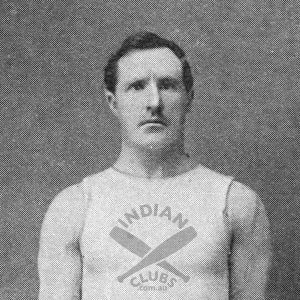 The man who quickly came to dominate these contests was Tom Burrows of Australia, and today he remains one of the most famous of all club swingers.
The man who quickly came to dominate these contests was Tom Burrows of Australia, and today he remains one of the most famous of all club swingers.
In 1895, at Aldershot, England, Burrows swung for 24 hours straight, establishing the world record. He continued to compete throughout the world, in South Africa, and Argentina, from Montreal to Cairo. Although other competitors arose to briefly take the new record, it was only a short matter of time before Burrows would take it right back again, leading one of his rivals to declare Burrows “invincible.”
Thomas Bax – NZ
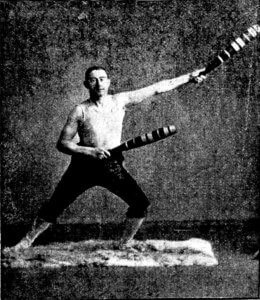 In 1895, however, a new figure emerged on the club-swinging scene named Thomas Bax. A hairdresser from London who had settled in New Zealand, Bax was a small man, standing a mere 5 foot 3 inches tall and weighing 146 pounds. He was also the oldest of the major competitors, only beginning his club-swinging career at the age of 45, or possibly 36—his birth year was a matter of dispute. Yet, for all his apparent disadvantages, Bax seemed to exhibit, nearly superhuman stamina and coolness that witnesses often remarked upon. It was recounted that he once walked 84 miles simply to catch a boat for Sydney. Bax was also a boxer, and an experienced soldier holding the volunteer rank of Lieutenant.
In 1895, however, a new figure emerged on the club-swinging scene named Thomas Bax. A hairdresser from London who had settled in New Zealand, Bax was a small man, standing a mere 5 foot 3 inches tall and weighing 146 pounds. He was also the oldest of the major competitors, only beginning his club-swinging career at the age of 45, or possibly 36—his birth year was a matter of dispute. Yet, for all his apparent disadvantages, Bax seemed to exhibit, nearly superhuman stamina and coolness that witnesses often remarked upon. It was recounted that he once walked 84 miles simply to catch a boat for Sydney. Bax was also a boxer, and an experienced soldier holding the volunteer rank of Lieutenant.
For a brief period, Bax took and re-took the world record from Burrows. During his contests, it was noted that whisky was rubbed into his body frequently, “producing good effects.” In 1897, Bax tied with an Australian heavy club swinger named Jack Griffiths at 40 hours, or nearly two days straight. Bax’s club swinging career, however, was then cut short by the outbreak of the Anglo-Boer War, in which he enlisted as a sergeant in New Zealand Mounted Rifles. For a time, Bax seemed to disappear.
Edinburgh
In 1902, in Edinburgh, Tom Burrows achieved a new record of 72 hours with 10,000 people watching the finale. However, the contest was broken into twelve-hour sessions across six days, allowing the contestants to break for sleep, so it was not continuous. Following this feat, nearly all endurance contests would allow no such breaks.
Queen of Clubs
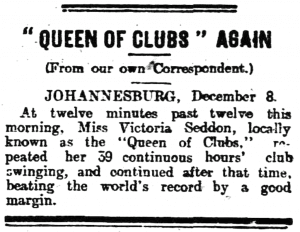 In the following years, female club-swinging champions emerged as well. In 1907, a formidable lady club and sword swinger from South Africa named Miss Victoria Seddon, who was able to swing four clubs at the same time, established a new female record of 45 hours non-stop.
In the following years, female club-swinging champions emerged as well. In 1907, a formidable lady club and sword swinger from South Africa named Miss Victoria Seddon, who was able to swing four clubs at the same time, established a new female record of 45 hours non-stop.
The next year, in 1908, a new record of 62 hours of continuous swinging was achieved by Stevens, a man of African descent, and a resident of Capetown, South Africa. Unfortunately, no pictures of either Victoria Seddon or Stevens are known to exist.
Food, Drink and Shaving
At this point, endurance contests lasting multiple days were posing obvious physiological challenges. Contestants would be fed, given drink, and even shaved daily—all the while continuously swinging. The food hand-fed to swingers included beef tea, hard-boiled eggs, biscuits, cocoa, port, and brandy. Tom Burrows recounted:
“You have to take nourishment during extended club swinging, however, no rest is allowed during which to swallow it. I keep up a series of back shoulder swings as a rule while my trainer puts food in my mouth with a spoon, but these can be varied with lower back swings if desired, and it must be confessed that there are not many foods that can be properly assimilated while one’s arms are continually revolving.”
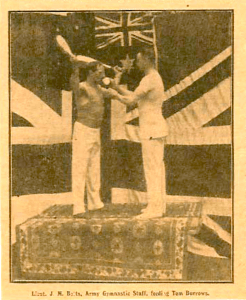
Contestants would swing on a stage, often with an orchestra or piano accompaniment, and audience members were encouraged to wander in throughout the day and night to observe. To ensure that these records were not disputed, entire committees of men were formed to attend these contests and certify the results.
Due to the challenges posed by sleep deprivation, these contests became just as much mental as physical. Modern scientists have discovered that, when deprived of sleep for days on end, parts of the human brain will actually shut down, and cause hallucinations. In one contest, after swinging for several days straight, Tom Burrows believed that every member of the audience was “swinging clubs with him”, which he described as a delusion, but a happy one.
The following pictures, taken at Bunbury in 1910, show the states of Tom Burrows before and after a swinging marathon of 75 hours.
A few months later, while attempting to establish yet another record, Burrows fell asleep onstage while swinging during the 97th hour, and collapsed in his wife’s arms. Still impressed, the audience erupted in cheers.
Amazing Endurance Contests 100 Hours
In April 1913, at Aldershot, England, Tom Burrows tried to establish a new record of more than 100 hours, in what would become the fight of his life.
“I had to fight with sleep, and what a fight was that my countrymen… the eyelids would stiffen and become like pieces of tin, and your senses got numbed. For a fraction of a second I would suddenly drop off, then suddenly start, as though roused from a nightmare, and fearful lest I had dropped my clubs, thus ending all… Coming to with a feeling of horror, I trembled like a leaf, but hot black coffee would generally revive me.”
Burrows did achieve the new record, but it came at something of a price. After four days of continuous swinging, during the 107th hour, one of Burrows’s trainers placed a wet sponge on the back of the champion’s neck. Now delusional from lack of sleep, Burrows became wild and attacked his trainers with his Indian clubs, and fists, before finally passing out cold. The next day, upon waking, Burrows admitted he had no memory of the assault, or indeed, of swinging at all the previous day.
“I wish now that I had stopped at 100 hours…I maintain that is just about the limit. You cannot remain up for five nights. I feel quite sure of that.”
This achievement would nevertheless remain the height of Burrows’s career and remains one of the best-documented endurance swings of all time.
Harry Lawson – USA
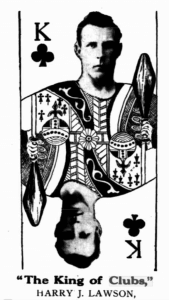 During the same year, Harry Lawson, an American from Kansas City, reportedly established a new swinging record of 134 hours, more than five days straight, in Australia. In response, a young Australian prodigy named Martin Dobrilla, a slim vegetarian known for his spartan habits and congenial demeanour, immediately raced to beat it.
During the same year, Harry Lawson, an American from Kansas City, reportedly established a new swinging record of 134 hours, more than five days straight, in Australia. In response, a young Australian prodigy named Martin Dobrilla, a slim vegetarian known for his spartan habits and congenial demeanour, immediately raced to beat it.
Harry Lawson attended his adversary’s marathon event but had to be forcibly removed by police when he protested the conditions. Lawson later publicly claimed that attendants were ringing a huge bell in Dobrilla’s ear to keep him awake, that Dobrilla was allowed to take seats at intervals, that his clubs often dangled stationary at his sides, with his trainers pushing them along, and that he sometimes engaged in “knob swinging” which was prohibited by the established rules. Dobrilla broke out into a rash, developed swollen legs which had to be bandaged, and reportedly lost 14 pounds during the course of the event.
Martin Dobrilla – AUS
 In response, Dobrilla’s supporters accused Lawson of hypocrisy, claiming that Lawson’s record had been attained under similar conditions. Although it’s impossible to know exactly whom to believe, it seems likely that the standards of both men were not quite in keeping with what Burrows had already achieved.
In response, Dobrilla’s supporters accused Lawson of hypocrisy, claiming that Lawson’s record had been attained under similar conditions. Although it’s impossible to know exactly whom to believe, it seems likely that the standards of both men were not quite in keeping with what Burrows had already achieved.
Whatever the case, it didn’t really matter, because both Lawson’s and Dobrilla’s records would soon be challenged once again from an unexpected source.
In 1914, news reports begin filtering out of New Zealand that the diminutive Thomas Bax, now in his mid-50s, had returned to club-swinging, and smashed Lawson and Dobrilla’s records. Back in Australia, a sceptical Dobrilla and his supporters made public inquiries as to the nature of Bax’s supposed record-breaking performance. A response was received from New Zealander Albert Mellor, who mentioned that while swinging during the 125th hour, one of Bax’s clubs had hit his knee and fallen out of his hand. The Australian press immediately seized upon this as evidence that Bax had actually not broken the record, due to the fallen club. Except that it actually wasn’t the truth. A review of the numerous reports from New Zealand at the time reveal what really happened.
125 Hours
On December 16th, Bax had attempted to break Dobrilla’s record, and indeed, 125 hours into his swinging, a club had struck his knee and fallen to the ground. However, undaunted, Bax immediately ceased swinging and set about recuperating for yet another entirely new attempt—which he began only one and a half weeks later, on Christmas Eve.
144 Hours
On New Years Day, New Zealand papers reported that Bax “beat the world record of 144 hours, at 9:27 tonight. He is still going strong and seems fresher now than four days ago. He appears to be enjoying the fun. Bax, who is 59 years of age, and a Londoner, says he will continue till midnight or after.”
146 Hours
On January 2nd, it was announced that Captain Thomas Bax had finally stopped swinging and established a new continuous record of 146 hours 33 minutes—more than six days straight—of continuous club swinging, in a feat that has never since been equalled in human history. So lucid was Bax towards the end, according to reports, that he was able to finish with two hours of fancy club swinging, which required even more agility and presence of mind than ordinary club swinging.
An Exceptionally Strong, Robust Man
Bax was, however, outside of New Zealand, completely dismissed and forgotten. He was not a self-promoter, and, unlike Lawson or Dobrilla, did not argue in newspapers or publicly dispute and affirm records. He showed up, swung his clubs, shook hands and left satisfied when it was all over. With the outbreak of World War I, Bax again disappeared into the military, serving in Egypt as Captain in the Imperial Camel Corps. Now in his mid-sixties, he was described during the war as “an exceptionally strong, robust man.”
One Fell Asleep
In 1917, Dobrilla made another attempt to break the record but stopped swinging at 84 hours. In 1928, two Englishmen made additional attempts, but one fell asleep after only 58 hours, while the other collapsed at 62 hours.
In 1929, Captain Bax was decorated with the Long Service Medal for his 25 years of military service. It was mentioned at the time in New Zealand that he was still “hale and hearty, and will be well remembered as the champion club swinger of the world, which record he still holds.” In 1942, at age 83, Thomas Bax died and was buried at Hastings Cemetery, New Zealand.
Unthinkable Today
In the end, it’s perhaps important to note that despite the controversies and disputes which occurred at the time, it doesn’t ultimately matter so much which of these particular men held the endurance record. Burrows, Seddon, Stevens, Lawson, Dobrilla, and Bax all pushed themselves to accomplish something that is almost unthinkable to the average modern human being today.
More than 100 Years Ago
In fact, it was more than 100 years ago, that these nearly forgotten individuals proved that the human mind, body, and spirit are capable of astounding things that many today would believe to be impossible—and that age and height are by no means barriers to such achievement. Or as one article on club-swinging at the time stated:
“It has proved that man is, after all, ‘the masterpiece of God’: that the limits to his powers that science has fixed are arbitrary and false.”
Lyrics sung by crowds attending Tom Burrows’s contests
- “Swing those clubs a little bit longer,
- Tommy Burrows do,
- You have friends on every side,
- Who will stand by you,
- Though your muscles are bound to ache,
- There are records you’re sure to break,
- So swing them a little bit longer,
- Tommy Burrows do.”
 I would like to thank Ben Miller for creating this video and allowing me to share it and providing the content for this post.
I would like to thank Ben Miller for creating this video and allowing me to share it and providing the content for this post.
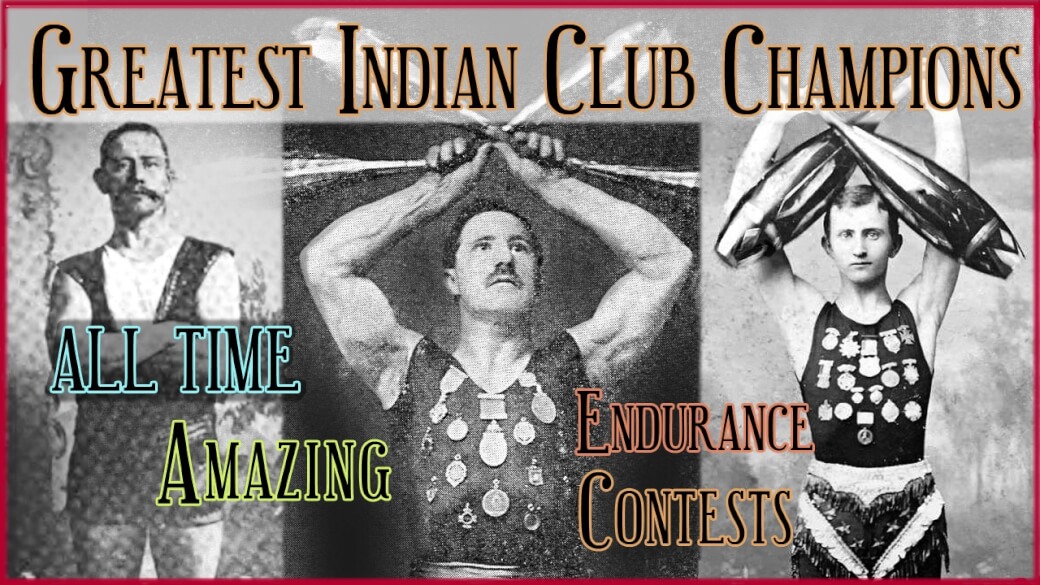

greeting from Australia. I loved your video.
I am wondering whether you might clarify an issue from me.
In a number of newspaper articles in 1938, particularly the Macleay Argus, a Harry Thomas from Macleay, NSW is reported as using the professional name of Harry J Lawson, world champion club swinger. In other articles he is described as an American, as he is in your video.
Harry Thomas (aka Lawson) is a relative of mine and I am wondering why the Australian would be described as an American.
I can send you clips from the various newspapers to verify my information if that would help set the records straight.
Hello Philip, I would love to see the clips in your possession. I have no idea why Harry Thomas (aka Lawson) would be referred to as an American rather than Australian.
The idea is strange as another fellow Australian and champion club swinger named Tom Burrows travelled extensively and was always called an Australian.
Looking forward to seeing your clips and photos if you have any. Regards. Paul